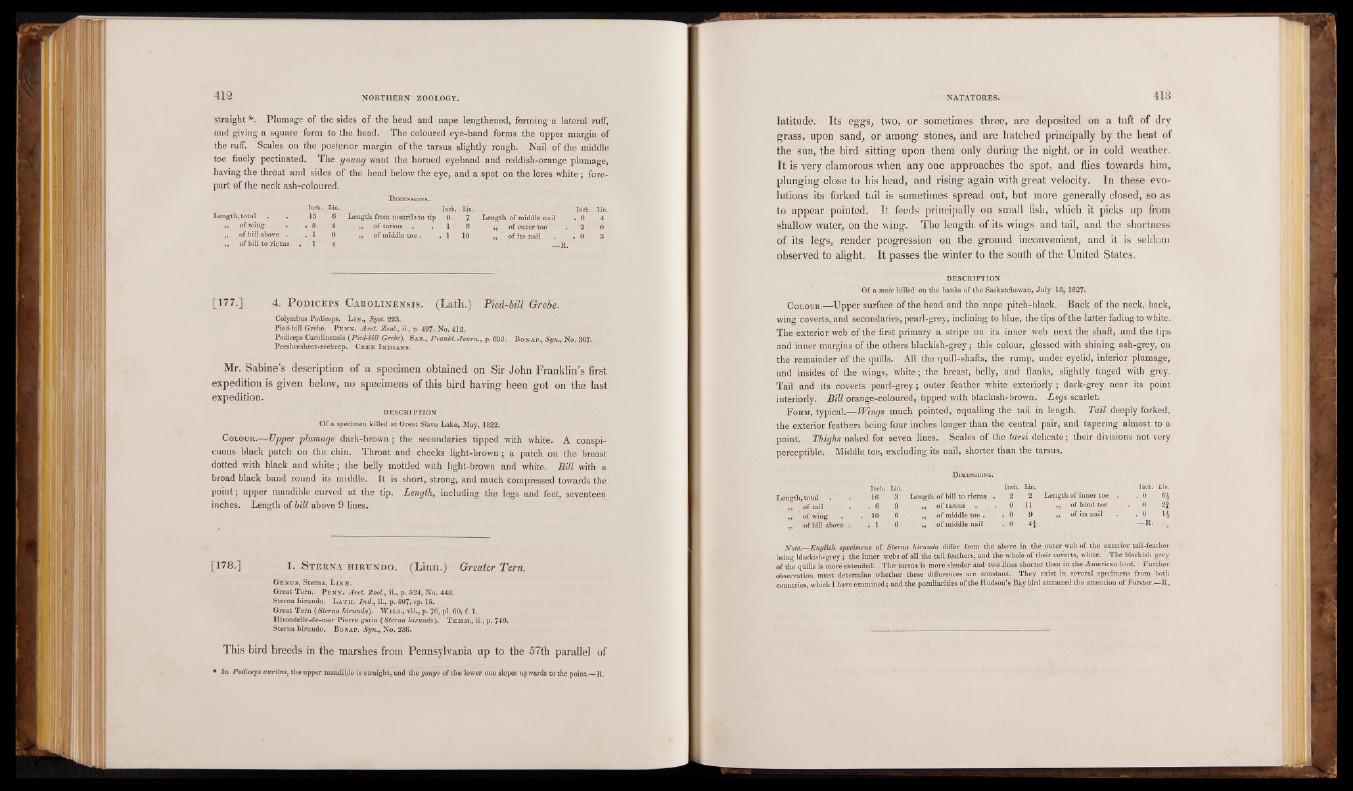
straight *. Plumage of the sides of the head and nape lengthened, forming a lateral ruff,
and giving a square form to the head. The coloured eye-band forms the upper margin of
the ruff. Scales on the posterior margin of the tarsus slightly rough. Nail of the middle
toe finely pectinated. The young want the horned eyeband and reddish-orange plumage,
having the throat and sides of the head below the eye, and a spot on the lores white ; forepart
of the neck ash-coloured.
Dimensions.
Inch. Lin. Length, total 15 Inch. . Lin. Inch. Lin ,, of wing . . 5 46 Length from nostrils to tip 0 7 Length of middle nail . 0 4 ,, of tarsus . . 1 8 '; of outer toe . 2 0 „ of bill above . . 1 0 ,, of middle toe . . 1 10 ,, of its nail . . 0 3 „ of bill to rictus . 1 4 —R.
[177.]?i) 4. P odiceps Carolinensis. (Lath.)i: Pied-bill Grebe. •-
Colymbus Podiceps. Lin ., Syst. 223.
Pied-bill Grebe. Penn. Arct. Zool., ii., p. 497, No. 418.
Podiceps Carolinensis (Pied-bill Grebe). Sab., Frankl. Joum., p. 692. Bonap., Syn., No. 367-
Peesheesbeet-seekeep. Cree Indians.
Mr. Sabine’s description of a specimen obtained on Sir John Franklin’s first
expedition is given below, no specimens of this bird having been got on the last expedition.
DESCRIPTION
Of a specimen killed at Great Slave Lake, May, 1822.
C olour.— Upper plumage dark-brown ; the secondaries tipped with white. A conspicuous
black patch on the chin. Throat and cheeks light-brown ; a patch on the breast
dotted with black and white; the belly mottled with light-brown and white. Bill with a
broad black band round its middle. It is short, strong, and much compressed towards the
point j upper mandible curved at the tip. Length, including the legs and feet, seventeen
inches. Length of hill above 9 lines.
[178.] 1. Sterna HiEUNDO. (Linn.) Greater Tern.
Genus, Sterna, L in n.
Great Tern. P enn. Arct. Zool., ii., p. 524, No. 448.
Sterna hirundo. Lath. Ind., ii., p. 807, sp. 15.
Great Tern (Sterna hirundo). W it’s., vii., p. 76, pi. 60, f. 1.
Hirondelle-de-mer Pierre garin (Sterna hirundo). Temm., ii., p. 740.
Sterna hirundo. Bonap. Syn., No. 286.
This bird breeds in the marshes from Pennsylvania up to the 57th parallel of
In Podiceps aurilus, the upper mandible is straight, and the gonys of the lower one slopes upwards to the point.—R.
latitude. Its eggs, two, or sometimes three, are deposited on a tuft of dry
grass, upon sand, or among stones, and are hatched principally by the heat of
the sun, the bird sitting upon them only during the night, or in cold weather.
It is very clamorous when any one approaches the spot, and flies towards him,
plunging close to his head, and rising again with great velocity. In these evolutions
its forked tail is sometimes spread out, but more generally closed, so as
to appear pointed. It feeds principally on small fish, which it picks up from
shallow water, on the wing. The length of its wings and tail, and the shortness
of its legs, render progression on the ground inconvenient, and it is seldom
observed to alight. It passes the winter to the south of the United States.
DESCRIPTION
Of a male killed on the banks of the Saskatchewan, July 18, 1827«
C olour.—Upper surface of the head and the nape pitch-black. Back of the neck, back,
wing coverts, and secondaries, pearlrgrey, inclining to blue, the tips of the latter fading to white.
The exterior web of the first primary a stripe on its inner web pext the shaft, and the tips
and inner margins of the others blackish-grey; this colour, glossed with shining ash-grey, on
the remainder of the quills. All the quill-shafts, the rump, under eyelid, inferior plumage,
and insides of the wings, white; the breast, belly, and flanks, slightly tinged with grey.
Tail and its coverts pearl-grey; outer feather white exteriorly ; dark-grey near its point
interiorly. Bill orange-coloured, tipped with blackish-brown. Legs scarlet.
F orm, typical.— Wings much pointed, equalling the tail in length. Tail deeply forked,
the exterior feathers being four inches longer than the central pair, and tapering almost to a
point. Thighs naked for seven lines. Scales of the tarsi delicate; their divisions not very
perceptible. Middle toe, excluding its nail, shorter than the tarsus.
Length, total
inch.
16
Lin.
3 Length of bill to rictus . 2 B Length of inner toe . 0
Lin.
H
„ of tail . 6 9 ,, of tarsus . 0 11 ,, of hind toe . 0 2§
,, of wing • . 10 6 „ of middle toe . . 0 9 ,, of its nail . 0 m
,, of bill above . 3 i 6 ,, of middle nail . . 0 4£ —R.
Note.—English specimens of Sterna hirundo differ from the above in the outer web of the exterior tail-feather
being blackish-grey; the inner webs of all the tail feathers, and the whole of their coverts, white. ' The blackish grey
of the quills is more extended. The tarsus is more slender and two lines shorter than in the American bird. > Further
observation must determine whether these differences are constant. They exist in several specimens from both
countries, which I have examined; and the peculiarities of the Hudson’s Bay bird attracted the attention of Forster.—R.